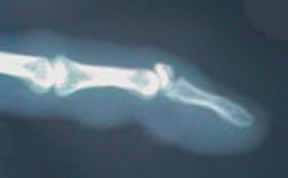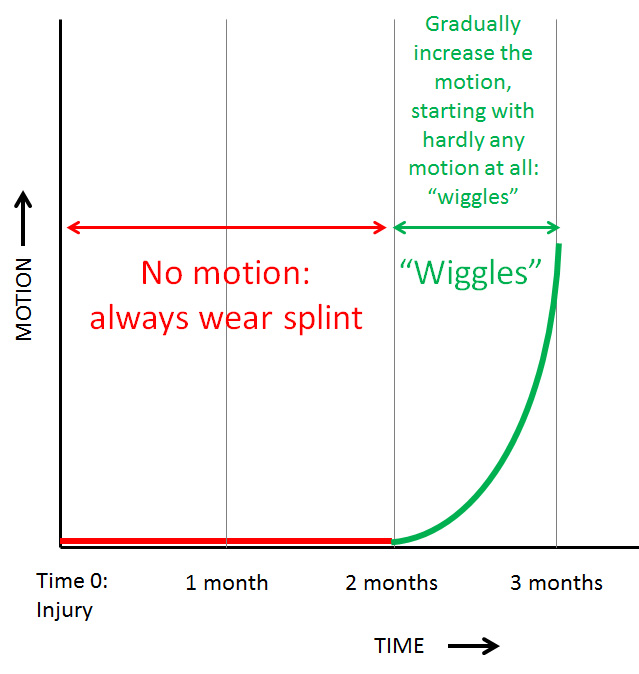Mallet Finger

Xray view of a bony mallet finger
Mallet finger is a condition caused by disruption of the tendon (extensor mechanism) of the finger joint at the base of the fingernail. The extensor mechanism can be disrupted in two places, either at the tendon or at the bone where the tendon inserts into the bone. If the problem is in the tendon, it is called a tendinous mallet finger. If the problem is caused by a fracture (see the xray above), then it is called a mallet fracture or bony mallet finger. Read all the material here and on the links I recommend: full patient education is essential to a good result. Most patients (>95%) will have a great, function result.
A mallet fracture will be immobilized for three weeks, then we will start gradual motion. A mallet finger will be immobilized for two months, then we will start gradual motion. See the diagram below, which shows the two month immobilization period for a mallet finger. Both a mallet finger and a mallet fracture will start the program of gradual motion I call "wiggles".
A great essay has been written on this by a friend of mine, Roy Meals, MD, a Clinical Professor of hand surgery at UCLA, and is on the eMedicine website. Another is the Mallet Finger Homepage by my friend, Charles Eaton, MD. Read both of these, including the treatment sections. The treatment is essentially the same one that I use, but remember my admonition on the Homepage: the information found on this (or any) website is not a substitute for personalized medical attention. You should not use this information, or the Internet in general, as a substitute for real medical care by a physician. No matter how hard you try, you will be giving yourself second-rate and substandard care. You deserve better care than that! Always consult a physician for medical care. If you feel that any of this material contradicts what I told you in the office, do what I told you, and bring a printout of the material to your next office visit.
There is a simple splint you can buy in the drugstore, called a Stack splint. The commercial ones do not always fit well, but can be used until you see me.
Once we start motion
It is very important that you understand the concept of PROGRESSIVE MOBILIZATION ("wiggles") once I start you on a program of moving your joint. We want to SLOWLY start motion and SLOWLY increase the motion, not go for broke right away. The first week, just remove your splint and wiggle the joint a little, about 10 degrees. Do this about five times a day, wearing the splint the rest of the time except for some periods while you are at rest, such as watching TV. Wear it at night. The second week, double the motion to about 20 degrees, and take the splint off a bit more, but wear it in the shower, while sleeping, and while active (when you might bump your finger). The third week you can move it more and wear the splint less, even taking it off at night. Wear it when you are active. The fourth week, you can move it a lot and keep the splint off except when you are active. After that week, you can take it off all the time, but avoid trauma for several more months.

This is a diagram for motion for a mallet finger; a mallet fracture is the same, but has only three weeks of immobilization. The key is the gradual increase of motion I call "wiggles".
BEWARE: if you develop a lag (cannot fully straighten the finger), put the splint back on and stop the movement exercises. Give me a call. I expect about a 5 degree lag in most cases, but it should not increase with time. If so, it may mean that you are stretching out the healing tendon. I want to talk to you and probably will need to see you to assess the situation.
This program of gradually increasing motion helps to strengthen the tendon as it limbers up the joint, which will be quite stiff from our treatment. Most patients recover a great, functional range of motion with only a slight lag.
